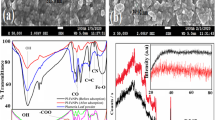Abstract
Green synthesis methods, nowadays, are being looked upon as a potential alternative to the already prevalent chemical and physical methods of synthesis of nanoparticles. In this present study, magnesium oxide (MgO) nanoparticles were synthesized from the flower extract of Madhuca longifolia by using microwave as a heating source. Morphological and compositional study was done using scanning electron microscopy along with energy-dispersive X-ray analysis (EDX). The functional group analysis was done by Fourier transform infrared spectroscopy. The synthesized magnesium oxide nanoparticles were used for the removal of nigrosine dye, and the removal took place in the presence of Ultra-Violet light (photocatalysis), exhibiting appreciable photocatalytic activity. The process of dye removal was optimized using Taguchi, and it was found that dye concentration was the major factor in the removal process. An experimental dye removal efficiency of 86% was obtained through the process. Further, experiments on adsorption kinetics and adsorption isotherms were done, and it was found that the process followed intra-particle diffusion rate kinetics and Freundlich’s adsorption isotherm model (indicating multilayer adsorption). The effect of temperature on the process of adsorption was also studied, and it was observed that higher temperatures facilitated better adsorption rates. Maximum adsorption took place at 60 °C, but the percentage removal at 60 °C was only 2 % higher, as compared to that at 45 °C. So, the dye removal process was carried out at 45 °C, taking into consideration the economics of the process. This was the first instance when magnesium oxide nanoparticles were synthesized from the flower extract of Madhuca longifolia and used as an adsorbent for the removal of nigrosine dye.













Similar content being viewed by others
References
Agrawal, S., Kulkarni, G. T., & Sharma, V. N. (2011). A comparative study on the antioxidant activity of methanolic extracts of Terminalia paniculata and Madhuca longifolia. Free Radicals Antioxidants, 1, 62–68. https://doi.org/10.5530/ax.2011.4.10
Alam, M. N., Roy, N., Mandal, D., & Begum, N. A. (2013). Green chemistry for nanochemistry: Exploring medicinal plants for the biogenic synthesis of metal NPs with fine-tuned properties. RSC Advances, 3, 11935–11956. https://doi.org/10.1039/c3ra23133j
Al-degs, Y. S., El-barghouthi, M. I., El-sheikh, A. H., & Walker, G. M. (2008). Effect of solution pH, ionic strength, and temperature on adsorption behavior of reactive dyes on activated carbon. Dyes and Pigment, 77, 16–23. https://doi.org/10.1016/j.dyepig.2007.03.001
Al-zboon, K. K. (2017). Nanoparticles composite, kaolin, and olive cake. Environment Development and Sustainability. https://doi.org/10.1007/s10668-017-0012-z
Alzboon, K. K., & Al-Harahsheh, M. S. (2019). Natural volcanic tuff for sustainable concrete industry Adsorption of uranium on natural and thermally activated zeolitic tuff : kinetic, thermodynamic and isotherm studies. International Journal of Environment and Waste Management., 24(1), 21–38.
Al-zboon, K. K., Al-smadi, B. M., & Al-khawaldh, S. (2016). Natural volcanic tuff-based geopolymer for Zn removal : Adsorption Isotherm, kinetic, and thermodynamic study. Water Air Soil Pollution, 227, https://doi.org/10.1007/s11270-016-2937-5
Athreya, S., & Venkatesh, Y. D. (2012). Application of Taguchi method for optimization of process parameters in improving the surface roughness of lathe facing operation. International Refereed Journal of Engineering Science, 1(13–19), 2319–1821.
Azizian, S. (2004). Kinetic models of sorption: A theoretical analysis. Journal of Colloid Interface Science, 276, 47–52. https://doi.org/10.1016/j.jcis.2004.03.048
Baker, S., Rakshith, D., Kavitha, K. S., Santosh, P., Kavitha, H. U., Rao, Y., & Satish, S. (2013). Plants: Emerging as nanofactories towards facile route in synthesis of nanoparticles. BioImpacts, 3, 111–117. https://doi.org/10.5681/bi.2013.012
Bankar, A., Joshi, B., Kumar, A. R., & Zinjarde, S. (2010). Banana peel extract mediated novel route for the synthesis of silver nanoparticles. Colloids Surfaces A Physicochemical Engineering Aspects, 368, 58–63. https://doi.org/10.1016/j.colsurfa.2010.07.024
Devi, N., & Sangeetha, R. (2016). Madhuca longifolia (Sapotaceae): A review of its phytochemical and pharmacological profile. International Journal Pharma Bio Science, 7, 106–114. https://doi.org/10.22376/ijpbs.2016.7.4.b106-114
Essien, E. R., Atasie, V. N., Okeafor, A. O., & Nwude, D. O. (2020). Biogenic synthesis of magnesium oxide nanoparticles using Manihot esculenta ( Crantz ) leaf extract. International Nano Letters, 10, 43–48. https://doi.org/10.1007/s40089-019-00290-w
Fakhri, A., & Adami, S. (2014). Adsorption and thermodynamic study of Cephalosporins antibiotics from aqueous solution onto MgO nanoparticles. Journal Taiwan Institute Chemical Engineers, 45, 1001–1006. https://doi.org/10.1016/j.jtice.2013.09.028
Font, R., Fullana, A., & Conesa, J. (2005). Kinetic models for the pyrolysis and combustion of two types of sewage sludge. Journal Analytical and Applied Pyrolysis, 74, 429–438. https://doi.org/10.1016/j.jaap.2004.10.009
Gudikandula, K., & Charya Maringanti, S. (2016). Synthesis of silver nanoparticles by chemical and biological methods and their antimicrobial properties. Journal of Experimental Nanoscience, 11, 714–721. https://doi.org/10.1080/17458080.2016.1139196
Gundogdu, A., Duran, C., Senturk, H. B., Soylak, M., Ozdes, D., Serencam, H., & Imamoglu, M. (2012). Adsorption of phenol from aqueous solution on a low-cost activated carbon produced from tea industry waste: Equilibrium, kinetic, and thermodynamic study. Journal of Chemical Engineering Data, 57, 2733–2743. https://doi.org/10.1021/je300597u
Ibrahim, H. M. M. (2015). Green synthesis and characterization of silver nanoparticles using banana peel extract and their antimicrobial activity against representative microorganisms. Journal Radiation Research and Applied Science, 8, 265–275. https://doi.org/10.1016/j.jrras.2015.01.007
Jahanshahi, M., Jahan-Bakhsh, R., Solmaz, H., & Razieh, J. S. (2007). Application of Taguchi method in the optimization of ARC-carbon nanotube fabrication. AIP Conference Proceedings, 929, 77–81. https://doi.org/10.1063/1.2776692
Khairallah, F., & Glisenti, A. (2007). Synthesis, characterization and reactivity study of nanoscale magnesium oxide. Journal of Molecular Catalysis A Chemical, 274, 137–147. https://doi.org/10.1016/j.molcata.2007.04.039
Mageshwari, K., Mali, S. S., Sathyamoorthy, R., & Patil, P. S. (2013). Template-free synthesis of MgO nanoparticles for effective photocatalytic applications. Powder Technology, 249, 456–462. https://doi.org/10.1016/j.powtec.2013.09.016
Moorthy, S. K., Ashok, C. H., Rao, K. V., & Viswanathan, C. (2015). Synthesis and characterization of Mgo nanoparticles by neem leaves through green method. Materials Today Proceedings, 2, 4360–4368. https://doi.org/10.1016/j.matpr.2015.10.027
Moussavi, G., & Mahmoudi, M. (2009). Removal of azo and anthraquinone reactive dyes from industrial wastewaters using MgO nanoparticles. Journal of Hazardous Materials, 168, 806–812. https://doi.org/10.1016/j.jhazmat.2009.02.097
Nagappa, B., & Chandrappa, G. T. (2007). Mesoporous nanocrystalline magnesium oxide for environmental remediation. Microporous Mesoporous Materials, 106, 212–218. https://doi.org/10.1016/j.micromeso.2007.02.052
Oktem, H., (2007). Application of Taguchi optimization technique in determining plastic injection molding process parameters for a thin-shell part, Materials & Design, 28, 1271–1278. https://doi.org/10.1016/j.matdes.2005.12.013
Ovais, M., Khalil, A. T., Ayaz, M., Ahmad, I., Nethi, S. K., & Mukherjee, S. (2018). Biosynthesis of metal nanoparticles via microbial enzymes: A mechanistic approach. International Journal of Molecular Science, 19, 1–20. https://doi.org/10.3390/ijms19124100
Ranjithkumar, V., Sangeetha, S., & Vairam, S. (2014). Synthesis of magnetic activated carbon/Fe2O3 nanocomposite and its application in the removal of acid yellow 17 dye from water. Journal of Hazardous Materials, 273, 127–135. https://doi.org/10.1016/j.jhazmat.2014.03.034
Sathyamoorthy, R., Mageshwari, K., Mali, S. S., Priyadharshini, S., & Patil, P. S. (2013). Effect of organic capping agent on the photocatalytic activity of MgO nanoflakes obtained by thermal decomposition route. Ceramics International, 39, 323–330. https://doi.org/10.1016/j.ceramint.2012.06.028
Selvam, N. C. S., Kumar, R. T., Kennedy, L. J., & Vijaya, J. J. (2011). Comparative study of microwave and conventional methods for the preparation and optical properties of novel MgO-micro and nano-structures. Journal of Alloys and Compounds, 509, 9809–9815. https://doi.org/10.1016/j.jallcom.2011.08.032
Shokoohi, R., Poormohammadi, A., & Azarian, G. (2016). Removal of bisphenol, using antimony nanoparticle multi-walled carbon nanotubes composite from aqueous solutions. Oriental Journal of Chemistry. https://doi.org/10.13005/ojc/320227
Simon, J. P., Parthasarathy, M., Nithyanandham, S., Katturaja, R. K., Namachivayam, A., & Prince, S. E. (2019). Protective effect of the ethanolic and methanolic leaf extracts of Madhuca longifolia against diclofenac-induced toxicity in female Wistar albino rats. Pharmacol Reports, 71, 983–993. https://doi.org/10.1016/j.pharep.2019.05.013
Singh, J., Dutta, T., Kim, K. H., Rawat, M., Samddar, P., & Kumar, P. (2018). “Green” synthesis of metals and their oxide nanoparticles: Applications for environmental remediation. Journal Nanobiotechnology, 16, 1–24. https://doi.org/10.1186/s12951-018-0408-4
Srivastava, V., Sharma, Y. C., & Sillanpää, M. (2015). Green synthesis of magnesium oxide nanoflower and its application for the removal of divalent metallic species from synthetic wastewater Varsha. Ceramics International, 41, 6702–6709. https://doi.org/10.1016/j.ceramint.2015.01.112
Tang, Z. X., & Lv, B. F. (2014). MgO nanoparticles as antibacterial agent: Preparation and activity. Brazilian Journal of Chemical Engineering, 31, 591–601. https://doi.org/10.1590/0104-6632.20140313s00002813
Umaralikhan, L., & Jaffar, J. M. (2018). Green synthesis of MgO nanoparticles and it antibacterial activity. Iran Journal of Science Technolgy Transaction A Science., 42, 477–485. https://doi.org/10.1007/s40995-016-0041-8
Yadav, P. (2012). Review MADHUCA LONIGFOLIA (Sapotaceae): A review of its traditional uses, phytochemistry and pharmacology. International Journal of Biomedical Research, 3, 291–305. https://doi.org/10.7439/ijbr.v3i7.292
Zhu, W., Liu, J., & Li, M. (2014). Fundamental studies of novel zwitterionic hybrid membranes: Kinetic model and mechanism insights into strontium removal. The Scientific World Journal, 1–7. https://doi.org/10.1155/2014/485820
Zolghadrnasab, H., (2016). Cadmium removal by using pumice modified with iron nanoparticles from aqueous solutions GlobalNEST International Journal, 18, 426–436.
Acknowledgements
The authors wish to express their gratitude to Department of Chemical Engineering, Visvesvaraya National Institute of Technology, Nagpur, for providing infrastructural and other necessary facilities to carry out this research work and Kunjan Junghare, Research Scholar (VNIT) for her support and engagement during the same.
Author information
Authors and Affiliations
Corresponding author
Additional information
Publisher's Note
Springer Nature remains neutral with regard to jurisdictional claims in published maps and institutional affiliations.
Rights and permissions
About this article
Cite this article
Choudhury, R., Kodape, S.M. & Bansod, P.G. Removal of nigrosine by MgO nanoparticles, green synthesized using Madhuca longifolia flower extract. Environ Dev Sustain 24, 6413–6434 (2022). https://doi.org/10.1007/s10668-021-01708-2
Received:
Accepted:
Published:
Issue Date:
DOI: https://doi.org/10.1007/s10668-021-01708-2




